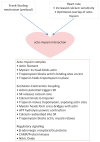Navigating Complexity in Postural Orthostatic Tachycardia Syndrome
- PMID: 39200375
- PMCID: PMC11352109
- DOI: 10.3390/biomedicines12081911
Navigating Complexity in Postural Orthostatic Tachycardia Syndrome
Abstract
Postural Orthostatic Tachycardia Syndrome (POTS) affects up to 1% of the US population, predominantly women, and is characterized by a complex, elusive etiology and heterogeneous phenotypes. This review delves into the intricate physiology and etiology of POTS, decoding the roles of the sinoatrial node, the autonomic nervous system, fluid dynamics, and the interplay between the immune and endocrine systems. It further examines key contributing factors such as dysautonomia, thoracic hypovolemia, autonomic neuropathies, sympathetic denervation, autoimmune responses, and associations with conditions such as small-fiber neuropathy and mast cell activation syndrome. Given the numerous mysteries surrounding POTS, we also cautiously bring attention to sinoatrial node and myocardial function, particularly in how the heart responds to stress despite exhibiting a normal cardiac phenotype at rest. The potential of genomic research in elucidating the underlying mechanisms of POTS is emphasized, suggesting this as a valuable approach that is likely to improve our understanding of the genetic underpinnings of POTS. The review introduces a tentative classification system for the etiological factors in POTS, which seeks to capture the condition's diverse aspects by categorizing various etiological factors and acknowledging co-occurring conditions. This classification, while aiming to enhance understanding and optimize treatment targets, is presented as a preliminary model needing further study and refinement. This review underscores the ongoing need for research to unravel the complexities of POTS and to develop targeted therapies that can improve patient outcomes.
Keywords: dysautonomia; genomics; myocardial function; thoracic hypovolemia.
Conflict of interest statement
The authors declared no potential conflicts of interest with respect to this research, authorship, and/or publication of this article.
Figures


Similar articles
-
Postural Orthostatic Tachycardia Syndrome (POTS): An Update for Clinical Practice.Curr Probl Cardiol. 2022 Dec;47(12):101384. doi: 10.1016/j.cpcardiol.2022.101384. Epub 2022 Aug 31. Curr Probl Cardiol. 2022. PMID: 36055438 Review.
-
Postural tachycardia syndrome - Diagnosis, physiology, and prognosis.Auton Neurosci. 2018 Dec;215:3-11. doi: 10.1016/j.autneu.2018.02.005. Epub 2018 Feb 28. Auton Neurosci. 2018. PMID: 29523389 Free PMC article. Review.
-
Autonomic nervous system dysfunction in adolescents with postural orthostatic tachycardia syndrome and chronic fatigue syndrome is characterized by attenuated vagal baroreflex and potentiated sympathetic vasomotion.Pediatr Res. 2000 Aug;48(2):218-26. doi: 10.1203/00006450-200008000-00016. Pediatr Res. 2000. PMID: 10926298
-
Postural tachycardia syndrome: a heterogeneous and multifactorial disorder.Mayo Clin Proc. 2012 Dec;87(12):1214-25. doi: 10.1016/j.mayocp.2012.08.013. Epub 2012 Nov 1. Mayo Clin Proc. 2012. PMID: 23122672 Free PMC article. Review.
-
Postural tachycardia syndrome and inappropriate sinus tachycardia: role of autonomic modulation and sinus node automaticity.J Am Heart Assoc. 2014 Apr 10;3(2):e000700. doi: 10.1161/JAHA.113.000700. J Am Heart Assoc. 2014. PMID: 24721800 Free PMC article.
Cited by
-
Pathophysiological mechanisms of Postural Orthostatic Tachycardia Syndrome analyzed by means of hemodynamics.PLoS One. 2025 Jul 2;20(7):e0327236. doi: 10.1371/journal.pone.0327236. eCollection 2025. PLoS One. 2025. PMID: 40601666 Free PMC article.
-
Long-COVID and postural orthostatic tachycardia syndrome: a preliminary comparison of neuropsychological performance.Clin Auton Res. 2025 Apr;35(2):285-299. doi: 10.1007/s10286-025-01106-y. Epub 2025 Jan 22. Clin Auton Res. 2025. PMID: 39838139 Free PMC article.
References
-
- Vernino S., Bourne K.M., Stiles L.E., Grubb B.P., Fedorowski A., Stewart J.M., Arnold A.C., Pace L.A., Axelsson J., Boris J.R. Postural orthostatic tachycardia syndrome (POTS): State of the science and clinical care from a 2019 National Institutes of Health Expert Consensus Meeting-Part 1. Auton. Neurosci. 2021;235:102828. doi: 10.1016/j.autneu.2021.102828. - DOI - PMC - PubMed
-
- Sheldon R.S., Grubb B.P., II, Olshansky B., Shen W.-K., Calkins H., Brignole M., Raj S.R., Krahn A.D., Morillo C.A., Stewart J.M., et al. 2015 Heart Rhythm Society Expert Consensus Statement on the Diagnosis and Treatment of Postural Tachycardia Syndrome, Inappropriate Sinus Tachycardia, and Vasovagal Syncope. Heart Rhythm. 2015;12:e41–e63. doi: 10.1016/j.hrthm.2015.03.029. - DOI - PMC - PubMed
Publication types
Grants and funding
LinkOut - more resources
Full Text Sources

